Dental anatomy and assessment of oral health
VerifiedAdded on 2021/01/02
|9
|2042
|412
AI Summary
Dental anatomy and assessment of oral health INTRODUCTION 4 1 LO 1 1 1.1 Describe the morphology, eruption dates and function of primary and secondary definition1 1.2 Describe structure of functions of gingivae and supporting tissue 1 1.3 Describe position and function of salivary glands and muscles of mastication 1 1.4 Describe structure of maxilla and mandible 1 1.5 Describe the movements of the temporo-mandibular joint 1 1.6 Describe nerve and blood supply to the teeth and supporting structures 2 LO 2 2 2.1 Explain
Contribute Materials
Your contribution can guide someone’s learning journey. Share your
documents today.
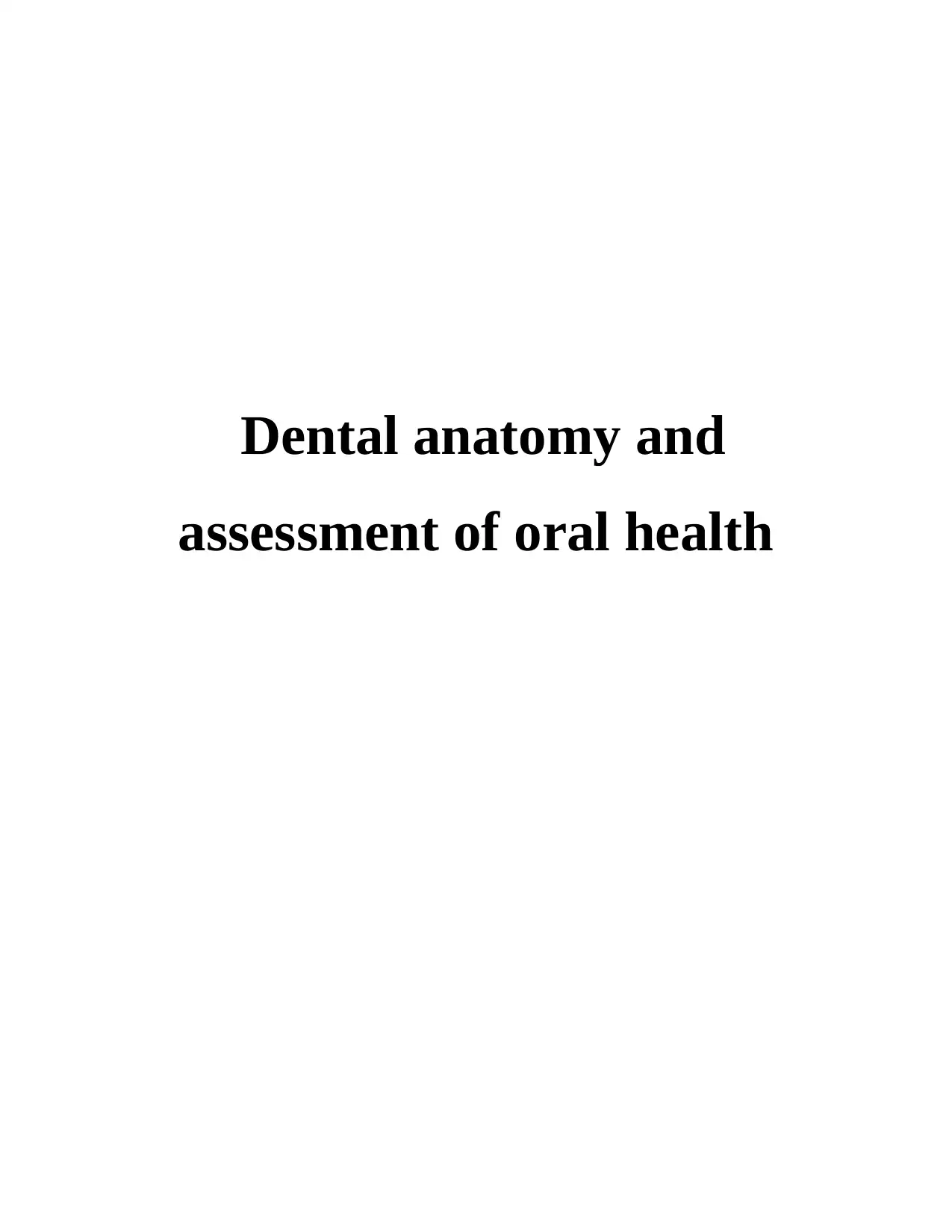
Dental anatomy and
assessment of oral health
assessment of oral health
Secure Best Marks with AI Grader
Need help grading? Try our AI Grader for instant feedback on your assignments.
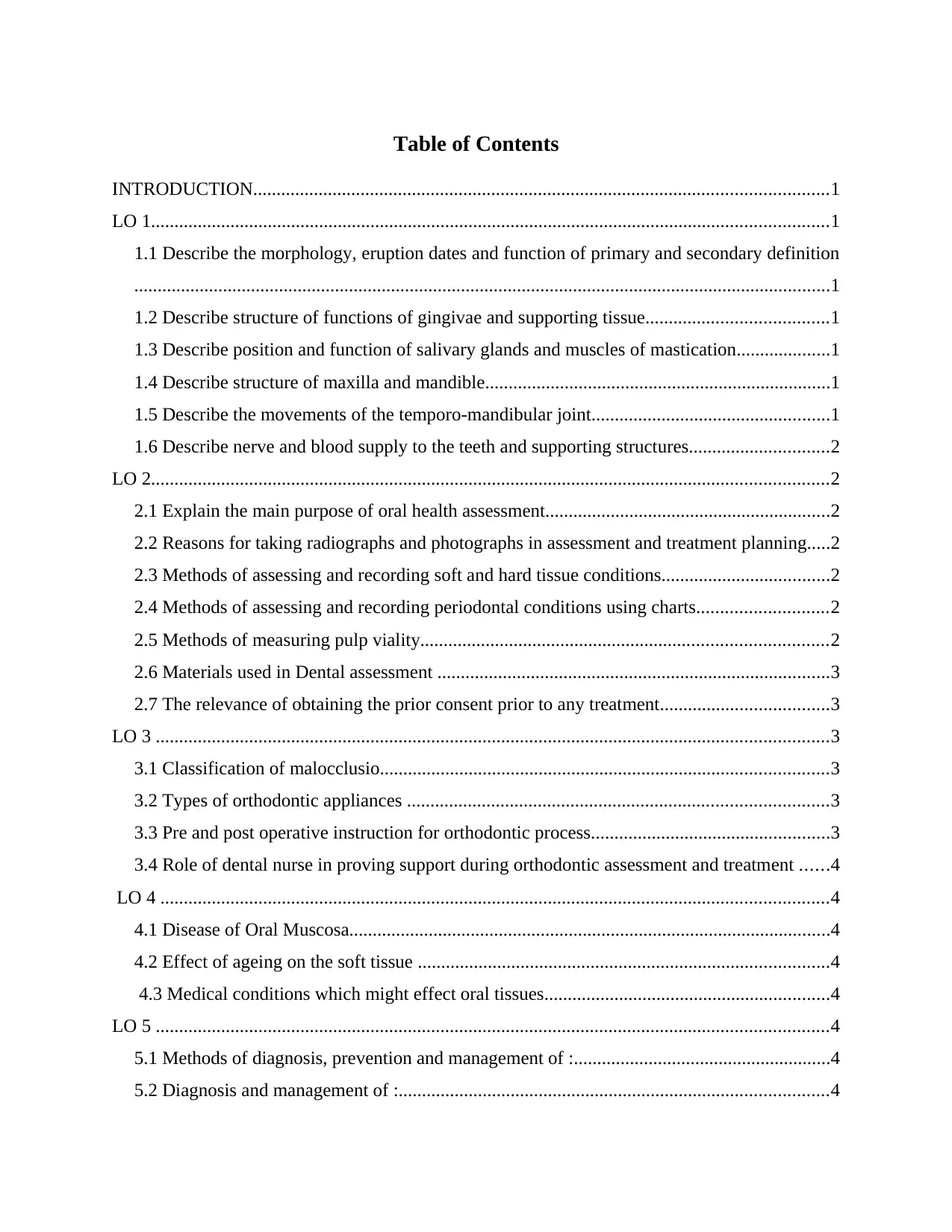
Table of Contents
INTRODUCTION...........................................................................................................................1
LO 1.................................................................................................................................................1
1.1 Describe the morphology, eruption dates and function of primary and secondary definition
.....................................................................................................................................................1
1.2 Describe structure of functions of gingivae and supporting tissue.......................................1
1.3 Describe position and function of salivary glands and muscles of mastication....................1
1.4 Describe structure of maxilla and mandible..........................................................................1
1.5 Describe the movements of the temporo-mandibular joint...................................................1
1.6 Describe nerve and blood supply to the teeth and supporting structures..............................2
LO 2.................................................................................................................................................2
2.1 Explain the main purpose of oral health assessment.............................................................2
2.2 Reasons for taking radiographs and photographs in assessment and treatment planning.....2
2.3 Methods of assessing and recording soft and hard tissue conditions....................................2
2.4 Methods of assessing and recording periodontal conditions using charts............................2
2.5 Methods of measuring pulp viality.......................................................................................2
2.6 Materials used in Dental assessment ....................................................................................3
2.7 The relevance of obtaining the prior consent prior to any treatment....................................3
LO 3 ................................................................................................................................................3
3.1 Classification of malocclusio................................................................................................3
3.2 Types of orthodontic appliances ..........................................................................................3
3.3 Pre and post operative instruction for orthodontic process...................................................3
3.4 Role of dental nurse in proving support during orthodontic assessment and treatment ......4
LO 4 ...............................................................................................................................................4
4.1 Disease of Oral Muscosa.......................................................................................................4
4.2 Effect of ageing on the soft tissue ........................................................................................4
4.3 Medical conditions which might effect oral tissues.............................................................4
LO 5 ................................................................................................................................................4
5.1 Methods of diagnosis, prevention and management of :.......................................................4
5.2 Diagnosis and management of :............................................................................................4
INTRODUCTION...........................................................................................................................1
LO 1.................................................................................................................................................1
1.1 Describe the morphology, eruption dates and function of primary and secondary definition
.....................................................................................................................................................1
1.2 Describe structure of functions of gingivae and supporting tissue.......................................1
1.3 Describe position and function of salivary glands and muscles of mastication....................1
1.4 Describe structure of maxilla and mandible..........................................................................1
1.5 Describe the movements of the temporo-mandibular joint...................................................1
1.6 Describe nerve and blood supply to the teeth and supporting structures..............................2
LO 2.................................................................................................................................................2
2.1 Explain the main purpose of oral health assessment.............................................................2
2.2 Reasons for taking radiographs and photographs in assessment and treatment planning.....2
2.3 Methods of assessing and recording soft and hard tissue conditions....................................2
2.4 Methods of assessing and recording periodontal conditions using charts............................2
2.5 Methods of measuring pulp viality.......................................................................................2
2.6 Materials used in Dental assessment ....................................................................................3
2.7 The relevance of obtaining the prior consent prior to any treatment....................................3
LO 3 ................................................................................................................................................3
3.1 Classification of malocclusio................................................................................................3
3.2 Types of orthodontic appliances ..........................................................................................3
3.3 Pre and post operative instruction for orthodontic process...................................................3
3.4 Role of dental nurse in proving support during orthodontic assessment and treatment ......4
LO 4 ...............................................................................................................................................4
4.1 Disease of Oral Muscosa.......................................................................................................4
4.2 Effect of ageing on the soft tissue ........................................................................................4
4.3 Medical conditions which might effect oral tissues.............................................................4
LO 5 ................................................................................................................................................4
5.1 Methods of diagnosis, prevention and management of :.......................................................4
5.2 Diagnosis and management of :............................................................................................4

5.3 Classes of drugs utilised in dentistry.....................................................................................5
Lo 6 .................................................................................................................................................5
6.1 Potential medical emergencies..............................................................................................5
6.2 Action can be taken in response to medical emergencies.....................................................5
CONCLUSION................................................................................................................................5
REFERENCES................................................................................................................................6
Lo 6 .................................................................................................................................................5
6.1 Potential medical emergencies..............................................................................................5
6.2 Action can be taken in response to medical emergencies.....................................................5
CONCLUSION................................................................................................................................5
REFERENCES................................................................................................................................6
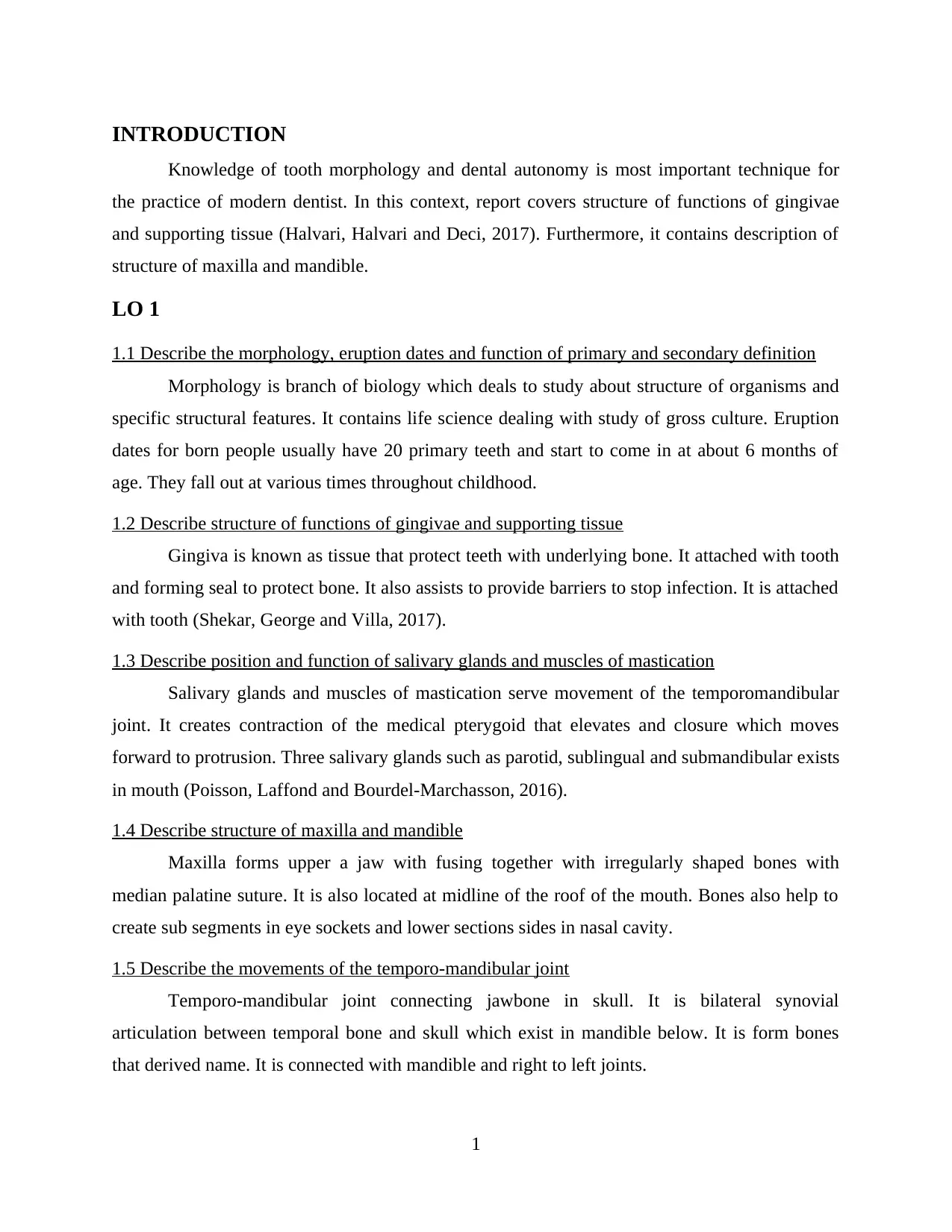
INTRODUCTION
Knowledge of tooth morphology and dental autonomy is most important technique for
the practice of modern dentist. In this context, report covers structure of functions of gingivae
and supporting tissue (Halvari, Halvari and Deci, 2017). Furthermore, it contains description of
structure of maxilla and mandible.
LO 1
1.1 Describe the morphology, eruption dates and function of primary and secondary definition
Morphology is branch of biology which deals to study about structure of organisms and
specific structural features. It contains life science dealing with study of gross culture. Eruption
dates for born people usually have 20 primary teeth and start to come in at about 6 months of
age. They fall out at various times throughout childhood.
1.2 Describe structure of functions of gingivae and supporting tissue
Gingiva is known as tissue that protect teeth with underlying bone. It attached with tooth
and forming seal to protect bone. It also assists to provide barriers to stop infection. It is attached
with tooth (Shekar, George and Villa, 2017).
1.3 Describe position and function of salivary glands and muscles of mastication
Salivary glands and muscles of mastication serve movement of the temporomandibular
joint. It creates contraction of the medical pterygoid that elevates and closure which moves
forward to protrusion. Three salivary glands such as parotid, sublingual and submandibular exists
in mouth (Poisson, Laffond and Bourdel‐Marchasson, 2016).
1.4 Describe structure of maxilla and mandible
Maxilla forms upper a jaw with fusing together with irregularly shaped bones with
median palatine suture. It is also located at midline of the roof of the mouth. Bones also help to
create sub segments in eye sockets and lower sections sides in nasal cavity.
1.5 Describe the movements of the temporo-mandibular joint
Temporo-mandibular joint connecting jawbone in skull. It is bilateral synovial
articulation between temporal bone and skull which exist in mandible below. It is form bones
that derived name. It is connected with mandible and right to left joints.
1
Knowledge of tooth morphology and dental autonomy is most important technique for
the practice of modern dentist. In this context, report covers structure of functions of gingivae
and supporting tissue (Halvari, Halvari and Deci, 2017). Furthermore, it contains description of
structure of maxilla and mandible.
LO 1
1.1 Describe the morphology, eruption dates and function of primary and secondary definition
Morphology is branch of biology which deals to study about structure of organisms and
specific structural features. It contains life science dealing with study of gross culture. Eruption
dates for born people usually have 20 primary teeth and start to come in at about 6 months of
age. They fall out at various times throughout childhood.
1.2 Describe structure of functions of gingivae and supporting tissue
Gingiva is known as tissue that protect teeth with underlying bone. It attached with tooth
and forming seal to protect bone. It also assists to provide barriers to stop infection. It is attached
with tooth (Shekar, George and Villa, 2017).
1.3 Describe position and function of salivary glands and muscles of mastication
Salivary glands and muscles of mastication serve movement of the temporomandibular
joint. It creates contraction of the medical pterygoid that elevates and closure which moves
forward to protrusion. Three salivary glands such as parotid, sublingual and submandibular exists
in mouth (Poisson, Laffond and Bourdel‐Marchasson, 2016).
1.4 Describe structure of maxilla and mandible
Maxilla forms upper a jaw with fusing together with irregularly shaped bones with
median palatine suture. It is also located at midline of the roof of the mouth. Bones also help to
create sub segments in eye sockets and lower sections sides in nasal cavity.
1.5 Describe the movements of the temporo-mandibular joint
Temporo-mandibular joint connecting jawbone in skull. It is bilateral synovial
articulation between temporal bone and skull which exist in mandible below. It is form bones
that derived name. It is connected with mandible and right to left joints.
1
Secure Best Marks with AI Grader
Need help grading? Try our AI Grader for instant feedback on your assignments.
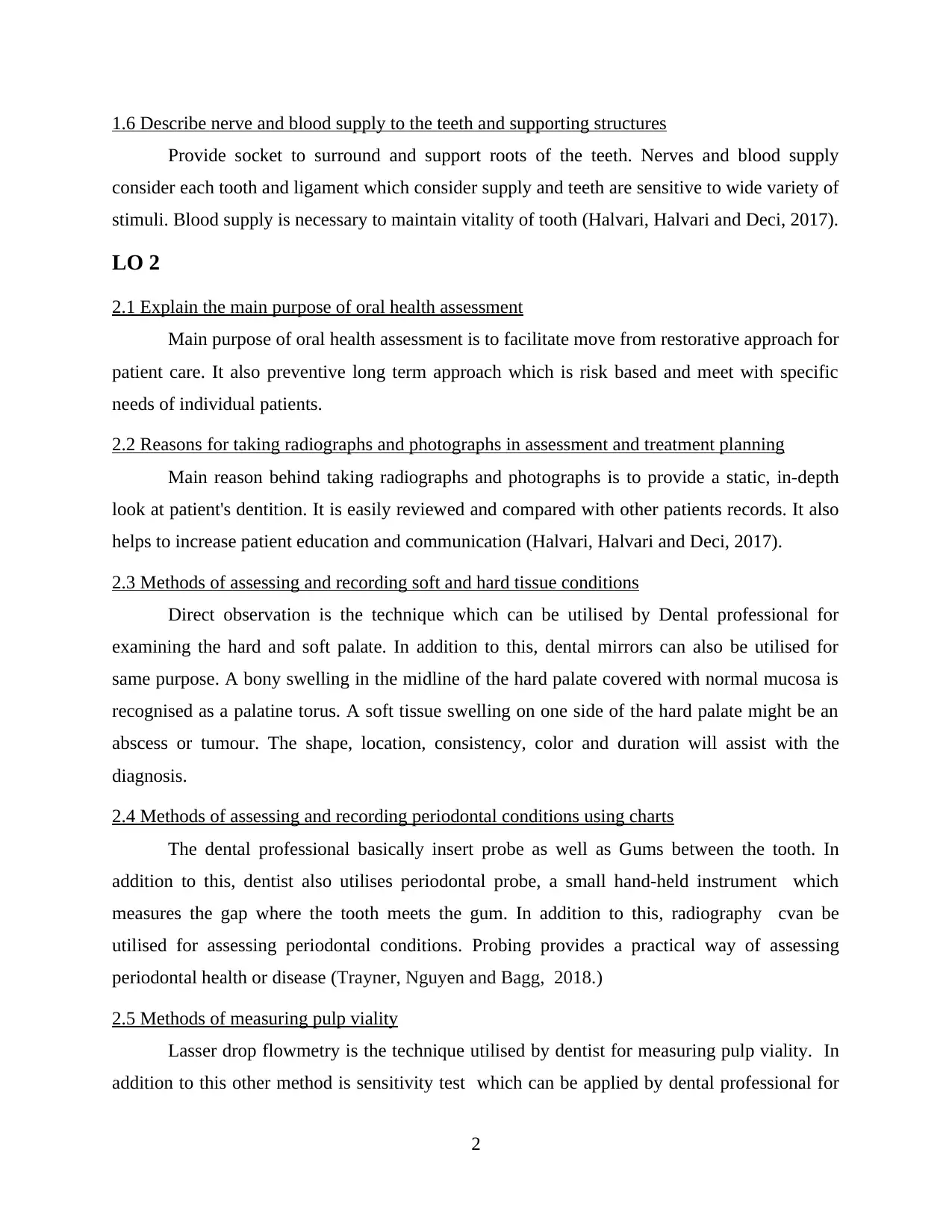
1.6 Describe nerve and blood supply to the teeth and supporting structures
Provide socket to surround and support roots of the teeth. Nerves and blood supply
consider each tooth and ligament which consider supply and teeth are sensitive to wide variety of
stimuli. Blood supply is necessary to maintain vitality of tooth (Halvari, Halvari and Deci, 2017).
LO 2
2.1 Explain the main purpose of oral health assessment
Main purpose of oral health assessment is to facilitate move from restorative approach for
patient care. It also preventive long term approach which is risk based and meet with specific
needs of individual patients.
2.2 Reasons for taking radiographs and photographs in assessment and treatment planning
Main reason behind taking radiographs and photographs is to provide a static, in-depth
look at patient's dentition. It is easily reviewed and compared with other patients records. It also
helps to increase patient education and communication (Halvari, Halvari and Deci, 2017).
2.3 Methods of assessing and recording soft and hard tissue conditions
Direct observation is the technique which can be utilised by Dental professional for
examining the hard and soft palate. In addition to this, dental mirrors can also be utilised for
same purpose. A bony swelling in the midline of the hard palate covered with normal mucosa is
recognised as a palatine torus. A soft tissue swelling on one side of the hard palate might be an
abscess or tumour. The shape, location, consistency, color and duration will assist with the
diagnosis.
2.4 Methods of assessing and recording periodontal conditions using charts
The dental professional basically insert probe as well as Gums between the tooth. In
addition to this, dentist also utilises periodontal probe, a small hand-held instrument which
measures the gap where the tooth meets the gum. In addition to this, radiography cvan be
utilised for assessing periodontal conditions. Probing provides a practical way of assessing
periodontal health or disease (Trayner, Nguyen and Bagg, 2018.)
2.5 Methods of measuring pulp viality
Lasser drop flowmetry is the technique utilised by dentist for measuring pulp viality. In
addition to this other method is sensitivity test which can be applied by dental professional for
2
Provide socket to surround and support roots of the teeth. Nerves and blood supply
consider each tooth and ligament which consider supply and teeth are sensitive to wide variety of
stimuli. Blood supply is necessary to maintain vitality of tooth (Halvari, Halvari and Deci, 2017).
LO 2
2.1 Explain the main purpose of oral health assessment
Main purpose of oral health assessment is to facilitate move from restorative approach for
patient care. It also preventive long term approach which is risk based and meet with specific
needs of individual patients.
2.2 Reasons for taking radiographs and photographs in assessment and treatment planning
Main reason behind taking radiographs and photographs is to provide a static, in-depth
look at patient's dentition. It is easily reviewed and compared with other patients records. It also
helps to increase patient education and communication (Halvari, Halvari and Deci, 2017).
2.3 Methods of assessing and recording soft and hard tissue conditions
Direct observation is the technique which can be utilised by Dental professional for
examining the hard and soft palate. In addition to this, dental mirrors can also be utilised for
same purpose. A bony swelling in the midline of the hard palate covered with normal mucosa is
recognised as a palatine torus. A soft tissue swelling on one side of the hard palate might be an
abscess or tumour. The shape, location, consistency, color and duration will assist with the
diagnosis.
2.4 Methods of assessing and recording periodontal conditions using charts
The dental professional basically insert probe as well as Gums between the tooth. In
addition to this, dentist also utilises periodontal probe, a small hand-held instrument which
measures the gap where the tooth meets the gum. In addition to this, radiography cvan be
utilised for assessing periodontal conditions. Probing provides a practical way of assessing
periodontal health or disease (Trayner, Nguyen and Bagg, 2018.)
2.5 Methods of measuring pulp viality
Lasser drop flowmetry is the technique utilised by dentist for measuring pulp viality. In
addition to this other method is sensitivity test which can be applied by dental professional for
2
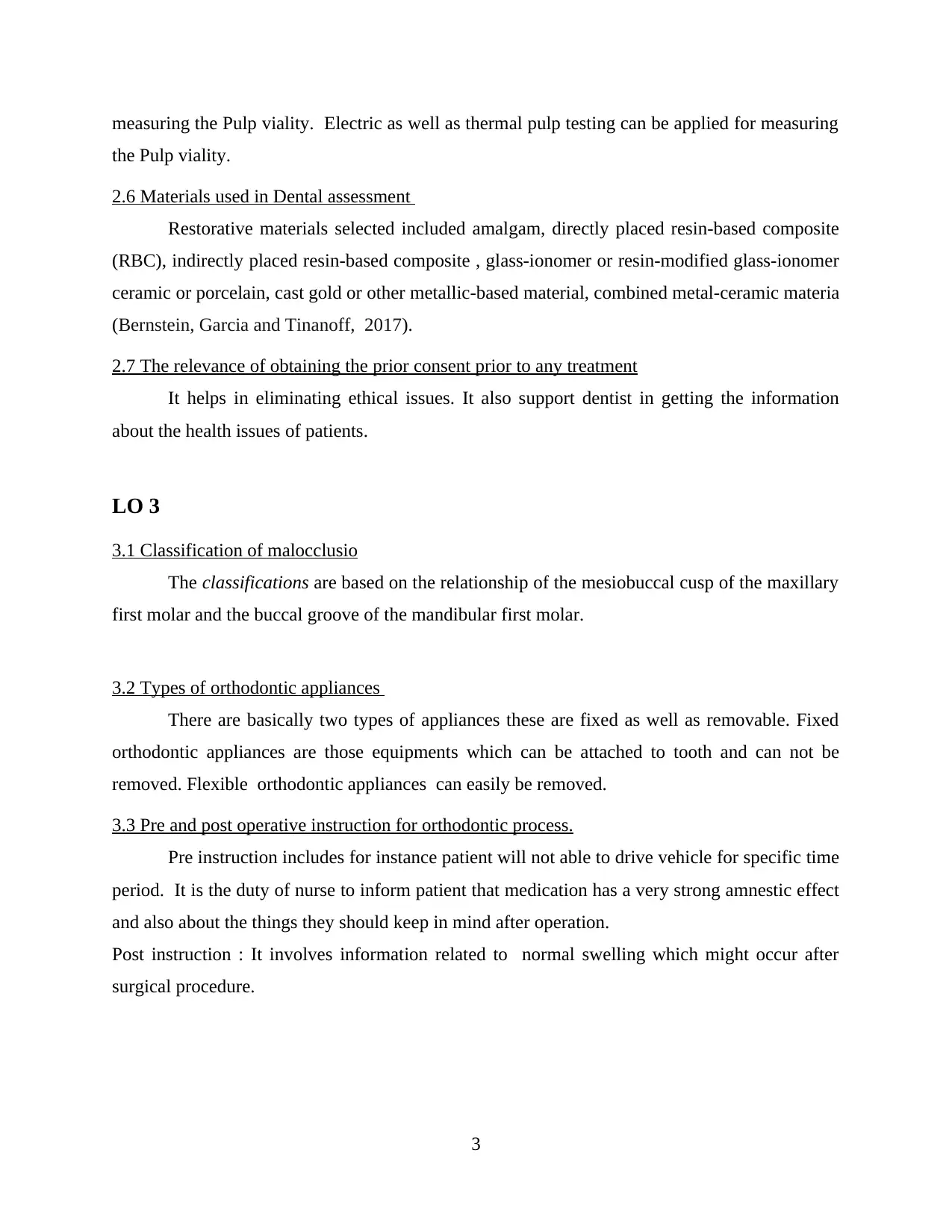
measuring the Pulp viality. Electric as well as thermal pulp testing can be applied for measuring
the Pulp viality.
2.6 Materials used in Dental assessment
Restorative materials selected included amalgam, directly placed resin-based composite
(RBC), indirectly placed resin-based composite , glass-ionomer or resin-modified glass-ionomer
ceramic or porcelain, cast gold or other metallic-based material, combined metal-ceramic materia
(Bernstein, Garcia and Tinanoff, 2017).
2.7 The relevance of obtaining the prior consent prior to any treatment
It helps in eliminating ethical issues. It also support dentist in getting the information
about the health issues of patients.
LO 3
3.1 Classification of malocclusio
The classifications are based on the relationship of the mesiobuccal cusp of the maxillary
first molar and the buccal groove of the mandibular first molar.
3.2 Types of orthodontic appliances
There are basically two types of appliances these are fixed as well as removable. Fixed
orthodontic appliances are those equipments which can be attached to tooth and can not be
removed. Flexible orthodontic appliances can easily be removed.
3.3 Pre and post operative instruction for orthodontic process.
Pre instruction includes for instance patient will not able to drive vehicle for specific time
period. It is the duty of nurse to inform patient that medication has a very strong amnestic effect
and also about the things they should keep in mind after operation.
Post instruction : It involves information related to normal swelling which might occur after
surgical procedure.
3
the Pulp viality.
2.6 Materials used in Dental assessment
Restorative materials selected included amalgam, directly placed resin-based composite
(RBC), indirectly placed resin-based composite , glass-ionomer or resin-modified glass-ionomer
ceramic or porcelain, cast gold or other metallic-based material, combined metal-ceramic materia
(Bernstein, Garcia and Tinanoff, 2017).
2.7 The relevance of obtaining the prior consent prior to any treatment
It helps in eliminating ethical issues. It also support dentist in getting the information
about the health issues of patients.
LO 3
3.1 Classification of malocclusio
The classifications are based on the relationship of the mesiobuccal cusp of the maxillary
first molar and the buccal groove of the mandibular first molar.
3.2 Types of orthodontic appliances
There are basically two types of appliances these are fixed as well as removable. Fixed
orthodontic appliances are those equipments which can be attached to tooth and can not be
removed. Flexible orthodontic appliances can easily be removed.
3.3 Pre and post operative instruction for orthodontic process.
Pre instruction includes for instance patient will not able to drive vehicle for specific time
period. It is the duty of nurse to inform patient that medication has a very strong amnestic effect
and also about the things they should keep in mind after operation.
Post instruction : It involves information related to normal swelling which might occur after
surgical procedure.
3
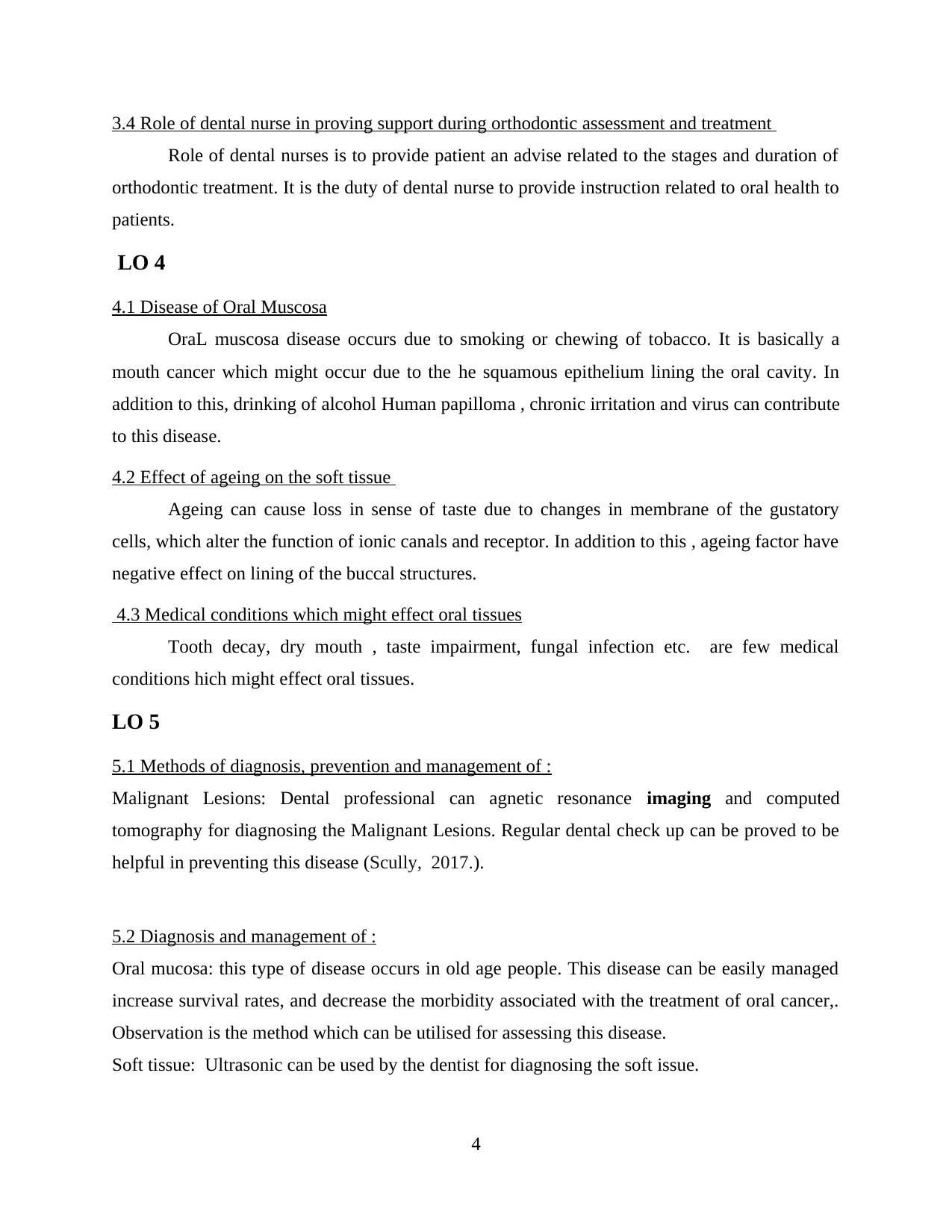
3.4 Role of dental nurse in proving support during orthodontic assessment and treatment
Role of dental nurses is to provide patient an advise related to the stages and duration of
orthodontic treatment. It is the duty of dental nurse to provide instruction related to oral health to
patients.
LO 4
4.1 Disease of Oral Muscosa
OraL muscosa disease occurs due to smoking or chewing of tobacco. It is basically a
mouth cancer which might occur due to the he squamous epithelium lining the oral cavity. In
addition to this, drinking of alcohol Human papilloma , chronic irritation and virus can contribute
to this disease.
4.2 Effect of ageing on the soft tissue
Ageing can cause loss in sense of taste due to changes in membrane of the gustatory
cells, which alter the function of ionic canals and receptor. In addition to this , ageing factor have
negative effect on lining of the buccal structures.
4.3 Medical conditions which might effect oral tissues
Tooth decay, dry mouth , taste impairment, fungal infection etc. are few medical
conditions hich might effect oral tissues.
LO 5
5.1 Methods of diagnosis, prevention and management of :
Malignant Lesions: Dental professional can agnetic resonance imaging and computed
tomography for diagnosing the Malignant Lesions. Regular dental check up can be proved to be
helpful in preventing this disease (Scully, 2017.).
5.2 Diagnosis and management of :
Oral mucosa: this type of disease occurs in old age people. This disease can be easily managed
increase survival rates, and decrease the morbidity associated with the treatment of oral cancer,.
Observation is the method which can be utilised for assessing this disease.
Soft tissue: Ultrasonic can be used by the dentist for diagnosing the soft issue.
4
Role of dental nurses is to provide patient an advise related to the stages and duration of
orthodontic treatment. It is the duty of dental nurse to provide instruction related to oral health to
patients.
LO 4
4.1 Disease of Oral Muscosa
OraL muscosa disease occurs due to smoking or chewing of tobacco. It is basically a
mouth cancer which might occur due to the he squamous epithelium lining the oral cavity. In
addition to this, drinking of alcohol Human papilloma , chronic irritation and virus can contribute
to this disease.
4.2 Effect of ageing on the soft tissue
Ageing can cause loss in sense of taste due to changes in membrane of the gustatory
cells, which alter the function of ionic canals and receptor. In addition to this , ageing factor have
negative effect on lining of the buccal structures.
4.3 Medical conditions which might effect oral tissues
Tooth decay, dry mouth , taste impairment, fungal infection etc. are few medical
conditions hich might effect oral tissues.
LO 5
5.1 Methods of diagnosis, prevention and management of :
Malignant Lesions: Dental professional can agnetic resonance imaging and computed
tomography for diagnosing the Malignant Lesions. Regular dental check up can be proved to be
helpful in preventing this disease (Scully, 2017.).
5.2 Diagnosis and management of :
Oral mucosa: this type of disease occurs in old age people. This disease can be easily managed
increase survival rates, and decrease the morbidity associated with the treatment of oral cancer,.
Observation is the method which can be utilised for assessing this disease.
Soft tissue: Ultrasonic can be used by the dentist for diagnosing the soft issue.
4
Paraphrase This Document
Need a fresh take? Get an instant paraphrase of this document with our AI Paraphraser

5.3 Classes of drugs utilised in dentistry
Some commonly prescribed medication in dentistry are ibuprofen, acetaminophen and
corticosteroids
Lo 6
6.1 Potential medical emergencies
Medial emergencies which can arise during the dental treatment includes diabetic coma,
cardiac arrest, asthma attack and fainting.
6.2 Action can be taken in response to medical emergencies
It is required by dental professional to quickly terminate treatment and remove all dental
materials and instruments from the patient’s mouth. In addition to this, dental professional to
maker the patient sit in comfortable position.
CONCLUSION
It has been concluded from the report that there are various disease which can be
occurred due to bad habits such as smoking as well as drinking of acohol. Study has also
concluded that asthma attack and fainting etc,. Can be the emergies which might occur due to
dental treatment.
5
Some commonly prescribed medication in dentistry are ibuprofen, acetaminophen and
corticosteroids
Lo 6
6.1 Potential medical emergencies
Medial emergencies which can arise during the dental treatment includes diabetic coma,
cardiac arrest, asthma attack and fainting.
6.2 Action can be taken in response to medical emergencies
It is required by dental professional to quickly terminate treatment and remove all dental
materials and instruments from the patient’s mouth. In addition to this, dental professional to
maker the patient sit in comfortable position.
CONCLUSION
It has been concluded from the report that there are various disease which can be
occurred due to bad habits such as smoking as well as drinking of acohol. Study has also
concluded that asthma attack and fainting etc,. Can be the emergies which might occur due to
dental treatment.
5
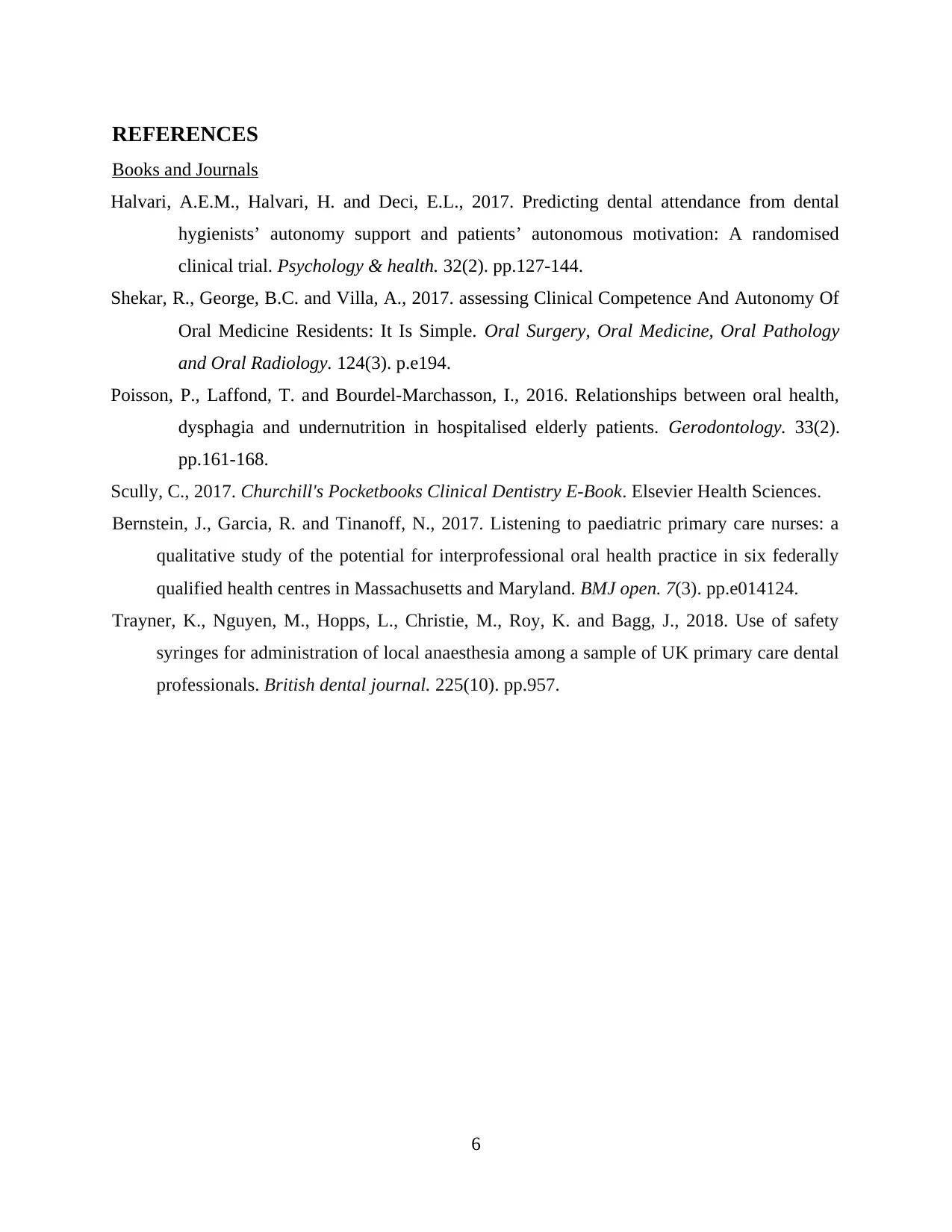
REFERENCES
Books and Journals
Halvari, A.E.M., Halvari, H. and Deci, E.L., 2017. Predicting dental attendance from dental
hygienists’ autonomy support and patients’ autonomous motivation: A randomised
clinical trial. Psychology & health. 32(2). pp.127-144.
Shekar, R., George, B.C. and Villa, A., 2017. assessing Clinical Competence And Autonomy Of
Oral Medicine Residents: It Is Simple. Oral Surgery, Oral Medicine, Oral Pathology
and Oral Radiology. 124(3). p.e194.
Poisson, P., Laffond, T. and Bourdel‐Marchasson, I., 2016. Relationships between oral health,
dysphagia and undernutrition in hospitalised elderly patients. Gerodontology. 33(2).
pp.161-168.
Scully, C., 2017. Churchill's Pocketbooks Clinical Dentistry E-Book. Elsevier Health Sciences.
Bernstein, J., Garcia, R. and Tinanoff, N., 2017. Listening to paediatric primary care nurses: a
qualitative study of the potential for interprofessional oral health practice in six federally
qualified health centres in Massachusetts and Maryland. BMJ open. 7(3). pp.e014124.
Trayner, K., Nguyen, M., Hopps, L., Christie, M., Roy, K. and Bagg, J., 2018. Use of safety
syringes for administration of local anaesthesia among a sample of UK primary care dental
professionals. British dental journal. 225(10). pp.957.
6
Books and Journals
Halvari, A.E.M., Halvari, H. and Deci, E.L., 2017. Predicting dental attendance from dental
hygienists’ autonomy support and patients’ autonomous motivation: A randomised
clinical trial. Psychology & health. 32(2). pp.127-144.
Shekar, R., George, B.C. and Villa, A., 2017. assessing Clinical Competence And Autonomy Of
Oral Medicine Residents: It Is Simple. Oral Surgery, Oral Medicine, Oral Pathology
and Oral Radiology. 124(3). p.e194.
Poisson, P., Laffond, T. and Bourdel‐Marchasson, I., 2016. Relationships between oral health,
dysphagia and undernutrition in hospitalised elderly patients. Gerodontology. 33(2).
pp.161-168.
Scully, C., 2017. Churchill's Pocketbooks Clinical Dentistry E-Book. Elsevier Health Sciences.
Bernstein, J., Garcia, R. and Tinanoff, N., 2017. Listening to paediatric primary care nurses: a
qualitative study of the potential for interprofessional oral health practice in six federally
qualified health centres in Massachusetts and Maryland. BMJ open. 7(3). pp.e014124.
Trayner, K., Nguyen, M., Hopps, L., Christie, M., Roy, K. and Bagg, J., 2018. Use of safety
syringes for administration of local anaesthesia among a sample of UK primary care dental
professionals. British dental journal. 225(10). pp.957.
6
1 out of 9
Your All-in-One AI-Powered Toolkit for Academic Success.
+13062052269
info@desklib.com
Available 24*7 on WhatsApp / Email
![[object Object]](/_next/static/media/star-bottom.7253800d.svg)
Unlock your academic potential
© 2024 | Zucol Services PVT LTD | All rights reserved.


